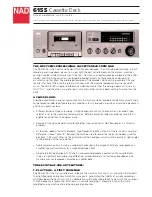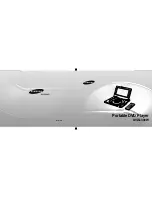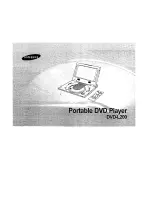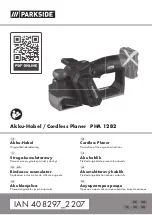
42
Installation and wiring
Carefully unpack the
CD-Player
and store the original
packing material carefully. The carton and packing are
specially designed for this unit and will be needed again
if you wish to move the equipment at any time.
Attention
The transport protector must be used
every time
the unit
is transported!
•
Open the CD drawer.
•
Disconnect the mains plug.
•
Wrap the transport protector round the opened CD
drawer; secure it with a small piece of adhesive tape if
necessary.
•
Carefully close the CD drawer by hand. When closing
the drawer check that the transport protector stays
neatly in place (see illustration).
Please read the safety notes in these instructions.
If the unit gets very cold (e. g. when being transported),
condensation may form inside it. Please do not switch it
on until it has had plenty of time to warm up to room
temperature, so that any condensation evaporates
completely.
Before placing the unit on a sensitive surface please
check the compatibility of the laquer and the unit's feet at
a non visible point.
The unit should be placed on a rigid, level base. When
placing the unit on resonance absorbers or anti-resonant
components make sure that the stability of the unit is not
reduced.
The unit should be set up in a well ventilated dry site, out
of direct sunlight and away from radiators.
The unit must not be located close to heat-producing
objects or devices, or anything which is heat-sensitive or
highly flammable.
When installing the unit on a shelf or in a cupboard it is
essential to provide an adequate flow of cooling air, to
ensure that the heat produced by the unit is dissipated
effectively. Any heat build-up will shorten the life of the
unit and could be a source of danger.
Mains and loudspeaker cables, and also remote control
leads (
RZ 001
) must be kept as far away as possible
from signal leads and antenna cables. Never run them
over or under the unit.
The wiring diagram shows a typical wiring arrangement
for the
CD-Player
within a
'R'
system.
Notes on connections:
•
Be sure to push all plugs firmly into their sockets.
Loose connections can cause hum and other
unwanted noises.
•
When you connect the output sockets of the CD
player to the input sockets of the amplifier always
connect like to like, i.e.
'R'
to
'R'
and
'L'
to
'L'
. If you
fail to heed this then the stereo channels will be
reversed.
•
Connect it to a correctly earthed mains socket using
the mains lead supplied.
•
To achieve maximum possible interference rejection
the mains plug should be connected to the mains
socket in such a way that phase is connected to the
mains socket contact marked with a dot (
). The
phase of the mains socket can be determined using a
special meter. If you are not sure about this, please
ask your specialist dealer.
•
We recommend the use of the
'POWER LINE'
ready-to-use mains cable and the
'POWER BAR'
mains distribution panel which is fitted with a phase
indicator as standard.
•
When you have completed the wiring of the system
please set the volume control to a very low level
before switching the system on.
The screen on the
CD-Player
should now light up, and
the unit should respond to the controls.
Place a CD in the machine and start playback by
pressing the
button.
When you select CD as listening source and switch on
your loudspeakers, you should hear music from the CD-
Player.
If you encounter problems when setting up and using the
CD player for the first time please remember that the
cause is often simple, and equally simple to eliminate.
Please refer to the section of these instructions entitled
'
Trouble shooting
'
.
Содержание CD 1260 R
Страница 1: ...V 1 1 Bestellnummer Order No 9103 0395 DE UK BETRIEBSANLEITUNG USER MANUAL CD 1260 R...
Страница 2: ...2...
Страница 16: ...16...
Страница 24: ...24...
Страница 25: ...25 English...
Страница 39: ...39...
Страница 47: ...47...
Страница 48: ...48 Anhang Appendix...
Страница 51: ...elektroakustik GmbH Co KG Herford Germany...










































